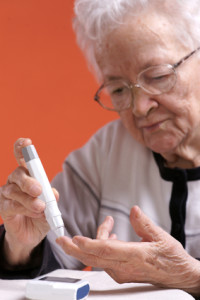Diabetes and Kidney Disease

More than 90 million Americans have high blood pressure and/or diabetes. Both of these diseases are leading causes of a silent killer, kidney disease.
For older adults, this is especially critical as studies show an increase of diabetes with aging due to factors such as obesity, decreased activity, and insulin resistance. Because of medical advances in the treatment of diabetes, patients with the disease are living longer, thus leading to more diabetes-related complications, such as kidney disease.
Kidney disease can develop as a result of a number of factors such as genetics, blood sugar, and blood pressure. If a diabetic person can keep his blood pressure under control, he’ll have a better chance of avoiding kidney disease.
The startling thing about kidney disease is that it produces few symptoms until kidney function is practically gone. Actual symptoms aren’t specific—fluid buildup, loss of sleep, poor appetite, and upset stomach—so it is hard to diagnose kidney disease initially. Diabetics need to see their doctors regularly, because they can check blood pressure, urine—for protein—and the blood for waste products and organs for other complications of diabetes.
Kidney disease works this way. After we eat proteins, our bodies digest them and then, create waste. The kidneys serve as filters for getting the waste out of the blood and into the urine. Tiny blood vessels push the waste out, while larger molecules like protein and red blood cells stay in the blood.
The high levels of blood sugar created by diabetes make the kidneys filter too much blood, which causes them to break down and filter out proteins into the urine. Overwork causes the kidneys filtering ability to shut down. Then, waste products then start to build up in the blood and the kidneys fail, which is called end-stage renal failure (ESRD). A person with ESRD needs to have a kidney transplant or to have the blood filtered by a dialysis machine.
Diabetics can prevent kidney disease by keeping their blood sugar in a target range. Tight blood sugar control can reduce the risk of microalbuminuria—the leakage of protein into the urine—by one third. In people who already had this condition, the risk of progressing was cut in half. Some doctors recommend a low-protein diet with microalbuminuria. Such a diet can decrease protein loss in the urine and increase protein levels in the blood. Diabetics should talk to their doctors before entering into such a diet.
Diabetics should also watch blood pressure and keep it under control. Blood pressure has a dramatic effect on the rate at which the disease progresses. A mild spike in blood pressure can quickly progress kidney disease. Diabetics can lower their blood pressures by losing weight, eating less salt, avoiding alcohol and tobacco, and exercising.
If these methods fail, particular medicines may be able to lower blood pressure. There are several kinds of blood pressure drugs; however, not all are equally good for people with diabetes. Doctors prefer people with diabetes to take blood pressure drugs called ACE inhibitors, which include captopril and enalapril. Recent research has shown ACE inhibitors to slow kidney disease in addition to lowering blood pressure. In fact, these drugs are helpful even in people who do not have high blood pressure.
When a diabetic’s kidneys fail, dialysis or a transplant are necessary. Patients should consult with their medical teams—nephrologists, internists and social workers—as they make these decisions.